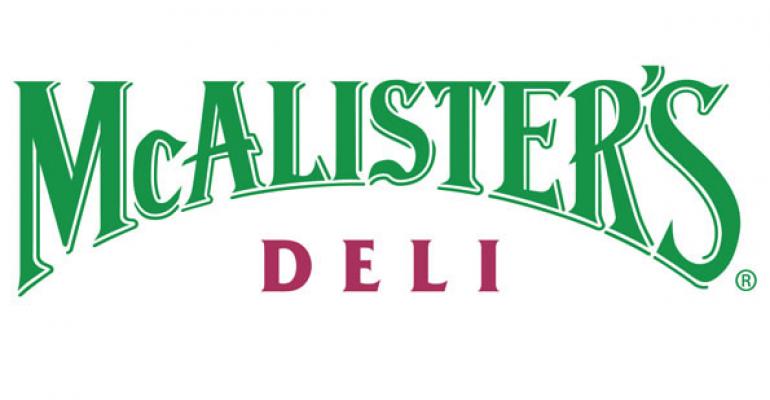McAlister’s Deli this spring has debuted a new prototype that refreshes the 23-year-old fast-casual concept and emphasizes its signature tea program with a stand-apart Tea Bar.
The new look debuted full scale at newly constructed franchised units in Lexington, Ky., and Aurora, Colo., in March. New elements were first vetted in a “heavy remodel” at a company restaurant in Clinton, Miss., that reopened in December, said Frank Paci, McAlister’s president and chief executive.
McAlister’s, which has 307 units in 22 states, has refreshed its colors and has started offering a variety of seating options, including traditional tables, booths and bar-height seating. In addition, McAlister’s offers amenities such as free Wi-Fi and a new Tea Bar.
McAlister’s is known for its sweet tea made with filtered water and cane sugar and is eyeing expansion of that signature offering with new options beyond its traditional black-tea blend.
Ridgeland, Miss.-based McAlister’s had U.S. systemwide sales of $384 million in 2011, up 7.56 percent from 2010, according to Nation’s Restaurant News Top 200 research. Systemwide estimated sales per unit, which is a proprietary NRN Top 200 number, rose 4.91 percent, to $1.26 million. The number of restaurants opened at the end of the fiscal year increased 0.66 percent, or by a net two units, to 305 locations, including 36 company-operated and 269 franchised units.
Paci talked earlier this week with Nation’s Restaurant News about the design changes and other initiatives at the company.
What are the biggest changes brought about by the new design?
If you look at our current design, it’s still got knickknacks on the wall. We’re going with a much cleaner look. We’ve put in this Tea Bar in the front counter. Now you order and go pick up your tea, as opposed to right now ordering at the counter and the cashier has to turn around and hand the tea to you — that slows down the line.
Take a look at McAlister’s new restaurant design; story continues below

What else are you planning to do with the Tea Bar?
Ultimately we’re looking at doing flavor shots and things like that within the tea. Tea is such a big part of our concept. We really wanted to romance that.
[The Tea Bar] also gives you a great opportunity to sample product there if we have something new. We’ve got a green tea going into one of the remodeled corporate stores, so we’re sampling the green tea at the Tea Bar there.
What are the operational advantages of the Tea Bar?
Right now, a guest kind of has to wait at the counter after completing an order to get the drinks. We can move that down to a separate area, where we can service you on the drinks. We also are adding self-serve cola. We can also make sure we have the right blend of ice with the tea.
Are you doing any customization?
When you come to the Tea Bar, you can tell us whether you want a half tea/half lemonade. We’ll look at fruit and other ways to customize the tea. It’s something that has potential.
Are you expanding your tea offerings?
In places where we have the Tea Bar, we have our traditional and sweet tea, and we’ve got a citrus green tea and a mango green tea. So we have four flavors. In regular locations, we only have two. We think our product deserves a premium. It’s served in a clear glass. We felt we wanted to romance that a little bit more. We’ve run campaigns where we say, “Leave sweet tea to the professionals.”
How have the design elements of the restaurant changed?
It’s got brighter colors. There are a lot of greens, and it was more muted in the past. It’s more updated. We’ve changed the dark green ceilings to white, which I think really opens up the store. We’ve installed different lighting. The original stores had brass rails and curtains from the mid-1990s.
Any changes in unit size?
Typically it’s 3,000 to 4,000 square feet. Probably the sweet spot is around 3,600 square feet. Seating ranges from 100 to 150. The sweet spot would be 124–125.
How about flexible formats?
We’ve got a couple of different designs. One of the challenges out there with development today is there is less new development, so a lot of times you have to look at going into second-use space. We have the flexibility to do end-cap concepts. We have franchisees who have built freestanding stores with a pick-up window, as well. And in part of that effort to be more convenient to our customers, we’re testing curbside [order delivery] in some locations.
How much curbside order delivery do you have?
We have that in two locations, which are company stores. [We've had] one for about six weeks, and the other one just started up.
If you are not going to have a drive thru, how do you make it convenient? When you bundle that with the mobile society, online ordering and catering to families (where’s it tough for mom if she’s got kids to get out of the car), your option becomes a drive thru or something else. One of the ways you compete is with curbside.
Is that difficult to add to operations?
We already have runners who deliver food to the table. Delivering food to a car really is not a stretch for us.
Alan Liddle contributed to this report.
Contact Ron Ruggless at [email protected].
Follow him on Twitter: @RonRuggless




